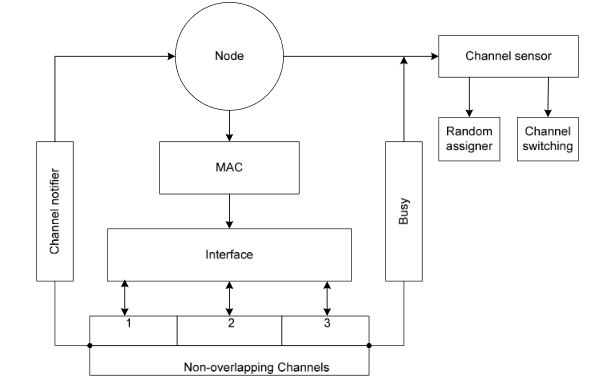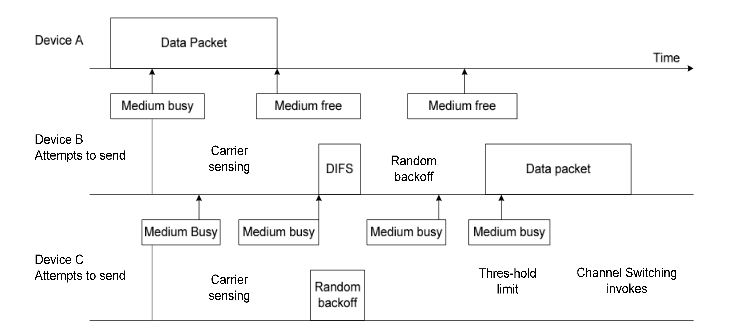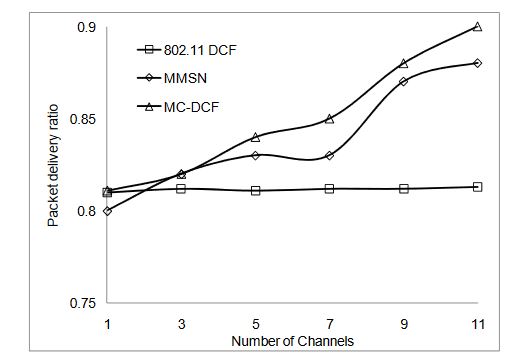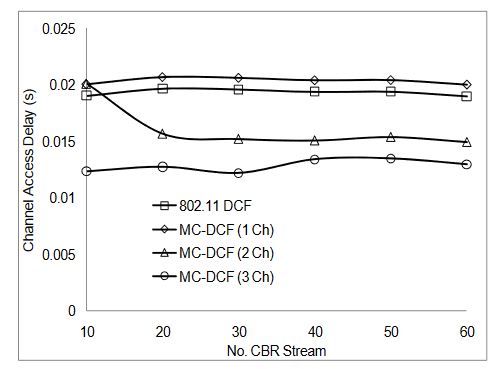ABSTRACT
Multi-channel assignments are becoming the solution of choice to improve performance in single radio for wireless networks. Multi-channel allows wireless networks to assign different channels to different nodes in real-time transmission. In this paper, we propose a new approach, Multi-channel Distributed Coordinated Function (MC-DCF) which takes advantage of multi-channel assignment.
The backoff algorithm of the IEEE 802.11 distributed coordination function (DCF) was modified to invoke channel switching, based on threshold criteria in order to improve the overall throughput for wireless sensor networks (WSNs) over 802.11 networks. We presented simulation experiments in order to investigate the characteristics of multi-channel communication in wireless sensor networks using an NS2 platform. Nodes only use a single radio and perform channel switching only after specified threshold is reached.
Single radio can only work on one channel at any given time. All nodes initiate constant bit rate streams towards the receiving nodes. In this work, we studied the impact of non-overlapping channels in the 2.4 frequency band on: constant bit rate (CBR) streams, node density, source nodes sending data directly to sink and signal strength by varying distances between the sensor nodes and operating frequencies of the radios with different data rates.
We showed that multi-channel enhancement using our proposed algorithm provides significant improvement in terms of throughput, packet delivery ratio and delay. This technique can be considered for WSNs future use in 802.11 networks especially when the IEEE 802.11n becomes popular thereby may prevent the 802.15.4 network from operating effectively in the 2.4 GHz frequency band.
RELATED WORK
Multi-channel assignment for WSNs has been studied by a number of researchers. The hybrid approach studied in are similar wherein each node has a fixed interface on a common channel which is used for package control and exchange while the other interfaces are switched among the remaining channels for data transmission.
Other hybrid multi-channel protocols in consist of two parts where in one part handles MAC issues such as queuing, switching and broadcast and the second part is a distributed assignment algorithm. These models maintain a table which records the channels being us ed by its neighbors. In this technique, nodes constantly check the table in order to determine the number of nodes assigned to a channel.
PROPOSAL FOR MC-DCF

Figure 2. MC-DCF design model
In Figure 2 during initialization of the network, the channel notifier uses combined functions from the management system in order to obtain information regarding the number of interfaces at the upper layer by invoking a logical communication with the distribution system medium (DSM) at the MAC sub layer. The channel notifier will assume that all nodes are in the same basic service set (BSS) and broadcast all the available channels within the BSS.

Figure 4. Contention period and channel switching
In Figure 4, if node A is transmitting a data packet and node B senses that the medium is busy and waits, after the initial attempt of waiting to transmit it senses the medium on the channel being used, attempts on the first retry and detects that the medium is free of other transmissions. The node waits for a predetermined DIFS (distributed inter-frame spacing) period, once it senses no other transmission before the end of the DIFS period, it computes a random back off time between values of CWmin and CWmax then commences its transmission.
RESULTS AND DISCUSSION

Figure 8. Delivery ratio impact on protocols
This gives evidence that MC-DCF will outperform MMSN in the 802.11 network, should both protocols operate within the data rate (from 2 Mbps up to 54 Mbps) of the 802.11 networks. 802.11 DCF does not show much variation as this protocol only operates on a single channel. In Figure 8, MC-DCF showed a better performance in packet deliver ratio to that of MMSN. This is due to the fact that the advantage of higher data rate has more packets delivering and receiving by each node.

Figure 9. Delay impact on CBR streams
We now studied the impact of the number of non-overlapping channel in the 2.4 frequency band of the 802.11 network. We varied the number of CBR streams, node generate packets toward the sink node, with the option to switch channel base on the MC-DCF backoff algorithm criteria. In Figure 9 when channel load reaches about 30 CBR stream, there is not much effect as it relates to delay in 802.11 DCF and when MC-DCF uses 1 channel.
CONCLUSIONS
In this paper, we proposed MC-DCF that is a backoff algorithm for multi-channel access based on the 802.11 DCF protocols. This algorithm allows node to have access to multiple non-overlapping channels by accessing channels dynamically through channel switching after a set threshold has been met. During the MC-DCF design, we analyzed and discussed the need for multi-channel assignment in WSN, where the future sensor surveillance system with streaming data may find it difficult to operate in 802.15.4 network due to congestion of the most frequently used 2.4 GHz frequency band.
The results from the simulation results proved futile for future development in this area for 802.11 networks. We observed that better performance is achieved when using MC-DCF in analyzing the impact of WSN in the 802.11 network. We further tested MC-DCF in 802.11 a/b/g networks at different distance and rates. We observed that at the 50 m range with 10 Mbps all network performed well. Overall 802.11 g performed well with all data rate and this is because it has the additional legacy for backward compatibility with 802.11b, up to 80% delivery rate was obtained.
Overall, MC-DCF exhibited prominent ability to utilize multi-channel transmission for the future with 802.11 for wireless sensor surveillance system that is low-cost, reliable, easy to manage, easy to deploy and can process video data for automated real-time alerts. Researchers will be able to achieve the goal of long term, independent operation of sens or network deployments under this constraint. Also 802.11 will be able to operate within the same frequency band in the capacity of 802.15.4 which is predicted to encounter severe problems when the proposed 802.11n networks become popular.
Source: Middlesex University
Authors: Carlene E.-A. Campbell | Kok-Keong (Jonathan) Loo | Orhan Gemikonakli | Shafiullah Khan | Dhananjay Singh
>> More Wireless Sensor Networks Projects Abstract for Engineering Students
>> More Wireless Projects Implementation in Ns2 for Engineering Students